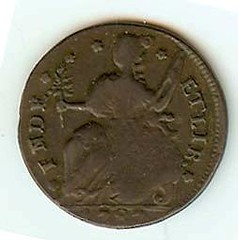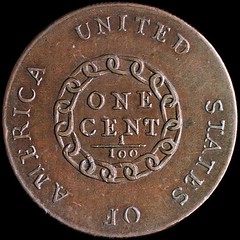
PREV ARTICLE
NEXT ARTICLE
FULL ISSUE
PREV FULL ISSUE
PROPOSED NEW TERMS FOR A NUMISMATIC ENCYCLOPEDIA
Some E-Sylum readers have responded to Dick Johnson's solicitation of numismatic terms for his forthcoming encyclopedia. Thanks!
-Editor
James Higby writes: I'd like to see the inclusion of the term bifurcation - the deformation of peripheral lettering due to inadequate availability of metal to fill the die. Most often this shows as a dent at the bottom of the upright part of the letters. It is often seen on early U.S. coins. Howard A. Daniel III writes: I am VERY sure Dick Johnson is looking for new terms in English but I could not resist sending one in Vietnamese. After writing my English language description of grading in my Socialist Republic of Viet Nam Coins & Currency catalog, I went to my many Vietnamese dictionaries to find the equivalent of Mint Strike (MS) or condition in Vietnamese. I could not find anything so I contacted several educated Vietnamese and we settled on the new term of Tinh Trang (TT). And it is also good for Print State (PS) for paper money. We are hoping it will show up in the next editions of the dictionaries. We shall see.
Some folks contacted Dick Johnson directly. Here's his report.
-Editor
Five E-Sylum readers responded to my request last week for terms perhaps they have created, to be included in my upcoming encyclopedia of coin and medal technology. I wish to thank Ken Bressett, James Higby, Ron Abler, Howard Daniel, and Mark Borckardt. Howard created a term in Vietnamese for MINT STATE and one for use for paper money as well. Then he surmised I wanted English terms only. Both outside the scope of terms I was seeking for diestruck items only, coins and medals.

"OK," he wrote, "you forced me into consulting my numismatic library (which I hope one day will house a copy of your forthcoming book!). I correctly remembered that it was Dr. M. H. Bolender who first came up with the term in his seminal work on early dollars, so I checked in the most recent manifestation thereof by the late, great Jules Reiver. Attached are scans of pages 7 and 8 of his The United States Early Silver Dollars 1794 to 1803 that update the Good Doctor's thoughts.
Mark Brockardt wrote "I am looking for a term to describe the Indian Head quarter eagles and half eagles of Bela Lyon Pratt, and they are different from what you have in your entry for SUNKEN RELIEF As I understand the terms, the Pratt designs are not INTAGLIO or INCISED They are not a "NEGATIVE RELIEF," rather a positive relief that is sunk into the surrounding surface (field) of the coin. I am unaware of any other instance where the Pratt technique is used in coinage. 'There has to be some sort of technical term that properly describes the Pratt design. I have often heard people describe these as "INCUSE, a term I consider entirely incorrect.' I insisted SUNKEN RELIEF was entirely correct. He responded then, "what is raised relief in a sunken panel, does such a term exist?" Raised relief in a sunken panel DOES have a name. It is called COELANAGLYPTIC RELIEF. All forms of relief in English come from their names in Italian. The Italian name for this is cavo-rilievo. This is the type of relief on ancient Egyptian walls and pyramids, so it is also known as EGYPTIAN HOLLOW RELIEF (which some writers shorten to just "hollow relief"). But in all cases the raised relief in the sunken panel does not exceed the level of the background or field. I cover six types of relief in my encyclopedia. The type of relief necessary for coin models is VERY LOW RELIEF which most of us simply call COIN RELIEF. Everyone knows it must have no undercutting and must have a slight bevel on the sides of all lettering, devices and images, as every die must strike and withdraw with this relief pressed into the surface of the blank. Yes this type of relief has an Italian name you never heard of: stiacciato. Artists are far freer in the use of a variety of reliefs on models from which medals are made as they do not have the restrictions of coins which must be struck complete in one blow. I greatly appreciate my correspondents' comments. And if you have a term that you use and would like to have considered, kindly fire it along. Or perhaps, a numismatic situation in which you would like to know if a term already exists. If you coin a new term, or term a new coin -- write me -- dick.johnson@snet.net
To read the earlier E-Sylum article, see:
DICK JOHNSON SEEKS NEW TERMS FOR NUMISMATIC ENCYCLOPEDIA
(www.coinbooks.org/esylum_v14n04a06.html)
The Numismatic Bibliomania Society is a non-profit organization promoting numismatic literature. See our web site at coinbooks.org. To submit items for publication in The E-Sylum, write to the Editor at this address: whomren@gmail.com To subscribe go to: https://my.binhost.com/lists/listinfo/esylum All Rights Reserved. NBS Home Page Contact the NBS webmaster 
|

